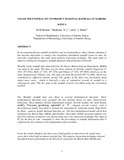| dc.description.abstract | In investigating Kenya rainfall variability and its relationship to other climatic elements it
has become imperative to analyze the irregularly distributed rainfall events in time. To
meet this requirement, this study used stepwise regression technique. The study seeks to
improve existing low frequency rainfall diagnosis and prediction in Nairobi.
Monthly totals rainfall data obtained from the Kenya Meteorological Department (KMD)
was used in the study. The data was for three stations in Nairobi, namely Dagoretti (10
18'S, 360 45'E), JKIA (10 19'S, 360 55'E) and Wilson (10 19'S, 360 49'E) which are on the
same homogeneous climatic zone. The data was from the period 1957 to 2002, which was
considered as sufficient climatic period. The quality of the data was ascertained using
single mass curve, which is basically a plot of cumulative records of rainfall in a
chronogical order. The few gaps in the rainfall records were filled using the correlation
method.
The Monthly rainfall data was fitted to several mathematical functions. These
mathematical functions were grouped into five families based on their characteristic
behaviour. These families include Exponential models, Growth models, the yield density
models, Processes producing sigmoidal or ‘S’ –shaped growth curves, and a
miscellaneous family described to include the sinusoidal fit, Gaussian model, Hyperbolic
fit, Heat - capacity model, Rational function, etc. The best mathematical model which best
simulated the March-May (MAM) and October -December (OND) seasonal rainfall over
the three stations of analysis was chosen using step wise regression technique The value of
R2 for the best fit was computed to show the percentage of rainfall information that is
explained by the variation in the independent (time) variable.
From the results obtained, the data was of high quality as depicted in the single mass
curve plots which had an almost straight line. The stepwise regression technique selected
the fourth degree polynomial as the best fit for analyzing the March-May (MAM) and October -December (OND) seasonal rainfall data set. The oscillations of the MAM and
OND rainfalls followed a unique repetitive pattern which was analogous to the solar cycle
period. Hence, solar cycle period of ten (10) years was employed to get the fourth degree
polynomial variables. The error sum of squares (SSE) [which was used to assess the
deviation of predicted rainfall values from the observed values] was computed for 5, 10
and 11 years periods , where it was also evident that the ten year period had the least
error as compared to 5 and 11 years periods.
Hence from the study, it was found that the 4th degree polynomial function can be used to
predict rainfall over Nairobi, with acceptable error values. This accurate rainfall forecast
will assist in the planning and management of all climate sensitive socio-economic
activities. | en |

